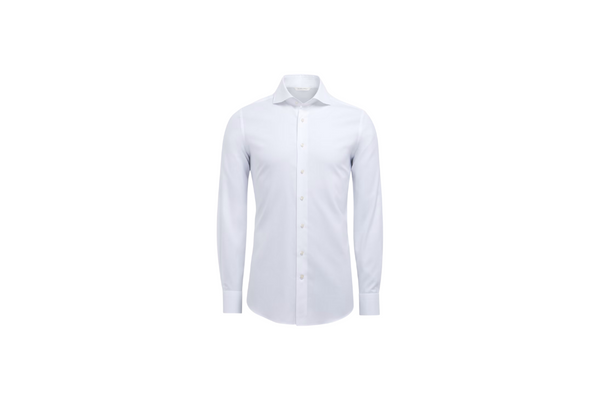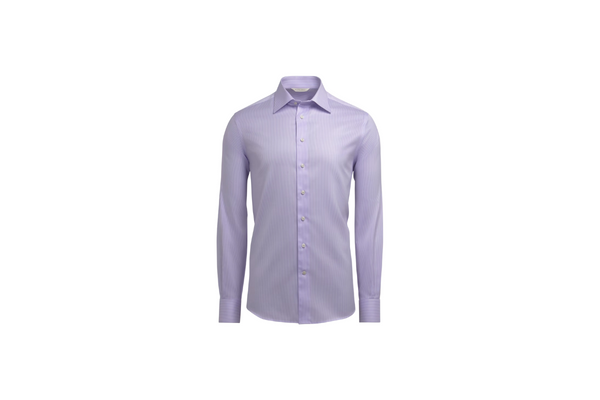HOW TO BUILD A CORE WARDROBE FOR MEN: DRESS SHIRTS
We have another installment of "Your Core Wardrobe," where we go over what stuff you need to have in your closet to build yourself a capsule wardrobe that pairs easily and covers all the bases.
This time, we're talking about dress shirts.
Although the world is dressing more casually these days, you still need to have a decent rotation of these shirts in your closet should the occasion arise.
Weddings, funerals, business happenings, and the occasional nice dinner will find you reaching for one of these shirts, so let's get you set up.
Here are a few tips to help you find the perfect shirt.
1. Dress shirt sizing is organized by neck size, not the regular Small, Medium, Large, etc., so you should know yours. You can measure yourself if you don't know it. Youtube it.
If you don't wear a tie and you want a slimmer fit, size down a half size. My neck size measures 16.5, but I usually opt for a 16-inch neck size so I can get a slightly slimmer fit through the body. I'm not buttoning the shirt anyway, so I'd rather take a better-fitting shirt.
The only time I would not recommend this is if you have a very slim neck and a large body, which rarely ever happens.
2. Nearly always try to go for a "Slim Fit" dress shirt, if not "Extra Slim". In almost a decade of doing this, I can count on one hand the number of men I've put in "Regular" fit shirts.
I know you might not think you're a slim guy, but trust me, a slim fit is less slim than you think. Typically, it just takes away a bit of the fabric from the sides of the shirt, helping you remove that muffin top look when you tuck in a shirt.
3. Speaking of, when tucking in a shirt, try using the "Miltary Tuck" method. It helps to keep your shirt tucked in nice and tight, also helping to reduce the amount of muffin-top-looking fabric hanging over your belt.
4. I typically like to make sure my dress shirts are made with non-iron fabric. I argue with menswear nerds about this a lot, who prefer more of a traditional fabric.
Non-iron shirts are generally treated in order to make them wrinkle-resistant. I find it's just easier to deal with. When shopping for a shirt, it helps to specify you're looking for something non-iron/wrinkle-resistant. I haven't ironed a dress shirt in years. However, I do steam them.
5. When storing/hanging your dress shirts, make sure you button the top button when hanging them. This will ensure the collar stays nice and crisp and doesn't fold/fall down when wearing it. It helps to use collar stays in your shirts as well.
Let's dive into the shirts you'll need to build out a good rotation. We'll get into brands and prices later.
THE WHITE SHIRT
The most classic shirt you can wear. There's nothing as crisp and clean as a good white dress shirt. It'll go with anything you pair with it. I like to use something like this when I'm wearing a jacket or trouser that is a bit louder, and I need something plain to tone down the energy.
THE BLUE SHIRT
The second most iconic shirt you can have is a plain blue shirt. You can wear this in place of white, although not as formal so don't try to wear it to any black-tie events.
I'll wear this when things are a bit conservative. It never offends or is too loud. It's my go-to when wearing a navy suit, as doing the monochromatic thing makes pairing easy.
THE STRIPED SHIRT
(I had to enlarge this one because screens and stripes don't mix well. Pro tip: I never put my clients who are on TV or in front of a camera a lot in close-together stripe pattern shirts as the shirt starts to look distorted).
This is probably my most used shirt out of the quiver. The stripe pattern gives it a bit more character and tones it down in terms of formality. I typically wear this with a pair of plain charcoal gray or navy trousers.
Another pro tip: if you're having trouble pairing, it's usually easiest to pair something patterned with something plain so that you're not worried about those patterns competing with each other. This is an oversimplification, but it makes it easy.
THE COLORED SHIRT
This is the lighthearted shirt you need to soften the mood. It's great when you're trying to soften the appearance of a bolder looking suit. It also works well for spring/summer weddings and more casual business attire.
THE DARK SHIRT
Sleek. Sexy. Whatever you want to call it. This works great on a night out. Wear it as is, or throw on a bold sportcoat over the top of this sucker to stand out. This works great for nighttime occasions, office parties, dinner and lounge dates, etc.
You could pair a darker navy jacket over this if you wanted to do a monochromatic look, but that can come off a bit ttwo-dimensionaland make you look like the bouncer at the bar you're going to.
Instead, I like to add a bit of contrast with the jacket I pair with it - something with some color and possibly a pattern. The black works well to create a neutral canvas for that jacket to really stand out.
---
Before we end, I'll give you some thoughts on where to buy your shirts and how much you should pay.
Two timeless PIVOT principles to keep in mind...
1. Buy the best you can afford. On average, a dress shirt will run you about a hundred.
2. Only shop from specialists (there are people who do one thing really well - buy from them. Neurosurgeon over General Practitioner).
Starting from the bottom up to the top in terms of price. All shirts pictured above are from Suit Supply.
Charles Tyrwhitt
Spier & Mckay
Kamakura Shirts
Suit Supply
Natalino
Eton
Budd
If you’re looking for personalized help improving your style, let’s chat. Book a 20-minute call with me here.
x Patrick





